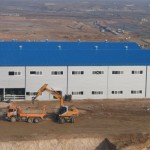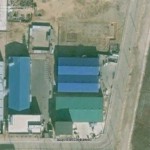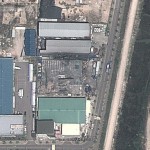New York Times
NORIMITSU ONISHI
5/25/2006
TAEJON, South Korea — At the Pyongyang Moran Bar on a recent Friday evening, a large video screen showed uplifting images of rocky mountains and an open blue sky. A slogan appeared at the bottom: “Kim Jong Il, a man who comes along only once in a thousand years.”
The North Korean waitresses wore traditional dresses in the bright colors that were fashionable in the South some years back. The singer’s interpretation of “Whistle,” a North Korean standard of the 1980’s, was shaky and off-key. Service was bad and included at least one mild threat. Drinks were spilled, beer bottles left unopened and unpoured.
But the South Korean customers could not get enough of the Pyongyang Moran Bar.
“Encore!” cried Bae Seong Wan, 44, at the end of “Whistle.”
The Pyongyang Moran Bar is located, not north of the demilitarized zone, but here in downtown Taejon, a city in the South Korean heartland.
The 120-seat bar opened in February, complete with inferior North Korean beverages, North Korean landscape posters, North Korean songs, a photo of Mr. Kim above the bar counter with his South Korean counterpart and, most important, North Korean waitresses — or, as a sign outside announced, “beautiful girls from North Korea!”
Until the 1990’s, South Korean schoolchildren were awarded prizes for drawing posters depicting diabolical North Koreans. Then the South’s so-called sunshine policy of engagement transformed North Koreans into real human beings in the minds of South Koreans and in popular movies like “Joint Security Area.”
Now, after more than half a decade of rapprochement, the North is all the rage, in a retro-kitschy fashion, and North Koreans are seen not as threatening aggressors but as country bumpkin cousins, needing an introduction to big-city life.
North Korean defectors and South Koreans alike are opening North Korean-themed restaurants, selling North Korean goods and auctioning off North Korean artwork on www.NKMall.com.
Half a century of division has turned the South into the world’s most wired society, as its consumer products and pop culture increasingly shape the tastes of youth across Asia.
North Korea, meanwhile, has remained frozen in time, a repository — at least to someone with a sharp nose for marketing — of an unchanged Korea.
“North Korea is retro,” said Jong Su Ban, 42, a North Korean defector who plans to open a North Korean restaurant, Ok Ru Ok, in Seoul soon. “It reminds South Koreans of the 1950’s and 1960’s, before South Korea industrialized. They see handmade crafts that are not sophisticated, and they think, ‘It’s like us before we developed.’ ”
The timing was right, Mr. Jong said, pointing out that only a few years ago a restaurant in Seoul with a waiter dressed as a North Korean soldier went belly up fast. “He made people uncomfortable,” he said.
At a company called NK Food, Hong Chang Ryo, 45, a South Korean who opened two North Korean restaurants in Seoul this year and is planning to open a third here, agreed.
“Even two or three years ago,” he said, “we couldn’t have done this. We would have been fingered as commies.”
Mr. Hong’s first restaurant, Nalrae, Nalrae — or fast, fast in the North Korean dialect — “invites you to a different taste” with more than 27 dishes named after places in the North. Shelves stocked with mushrooms, alcoholic beverages, seaweed — “straight from Pyongyang” — are the main attractions in the restaurant, which is painted organic green. A menu promises “nonpolluted, well-being dishes using natural resources from North Korea.”
“It feels rural, natural, unpolluted,” said one first-time customer, Lee Sae Mie, 23, a university student.
While about 40 percent of the dishes’ ingredients come from the North, Mr. Hong said, the flavors had to be adjusted, considerably, to appeal to South Korean palates.
“We had to rack our brains,” Mr. Hong said. “We all know they just eat cornmeal over there. Well, we just don’t know what they’re eating over there. So we mixed and matched. Dishes may look North Korean but actually taste South Korean.”
Increasingly, though, people are parting with South Korean won to buy goods from www.NKMall.com, which Park Young Bok, a South Korean, set up in 2003. The site sells mostly food products, which shoppers can also buy at 70 stores nationwide.
Last September, Mr. Park added an auction for North Korean paintings, which have been selling briskly, reaching $115,000 in sales in April. With South Korean officials still banning artwork with political content, most of the imports are of landscapes — though, oddly, a tapestry of the Virgin Mary was auctioned off recently for $80.
At his warehouse just outside Seoul, Mr. Park showed off some of the 30 North Korean alcoholic beverages he sells — some of them with labels slapped crookedly on the bottles, others with the contents partly evaporated because of poor bottling.
But to hear some of the patrons at the Pyongyang Moran Bar here tell it, leaking bottles, even bad service, are part of the North Korean appeal.
“I don’t know how to open this,” said one waitress struggling with a bottle of Budweiser. The waitress — who had worked at the bar for only two days and who, like many North Koreans, had never opened a bottle before — tried to get the top off, then handed the bottle to the customer, who opened it himself.
Another customer, Kim Chung Sig, 39, said, “I don’t expect the service to be good here.”
Choi Jung Hee, 37, the manager, said she had trouble training her North Korean staff of five waitresses. “At least, they should say, ‘Hello!’ properly when customers come in, but they don’t,” she said.
“Things are very different in North Korea,” she said. “Over there, waitresses and salespeople are kings because they have access to goods. But here you have to treat customers like kings. You have to bow to them and be polite even if they are rude.”
Reaction to the bar is decidedly split, an indication, said Mr. Jong, the North Korean who is opening up Ok Ru Ok, that South Koreans see in North Korea what they want to see.
Older South Koreans, who still look upon the North as an enemy, want to see images of starving North Korean babies, Mr. Jong said. Younger people, who often want friendly relations with the North, want to see the clean streets of Pyongyang.
“Both sides want to satisfy their beliefs,” Mr. Jong said, standing inside his soon-to-open restaurant. “That’s why I’ll put up only neutral images of North Korea in my new restaurant.”
Everything has fallen into place now for Mr. Jong, who came to South Korea in 2000 and earned a living writing pornography before plunging into food. He has even secured a supply of the North’s coveted Taedong River beer.
“When I lived in North Korea,” Mr. Jong said, “I never knew that this beer even existed. I’ll have North Korean beer for the first time in South Korea. I lived in a very funny country.”



